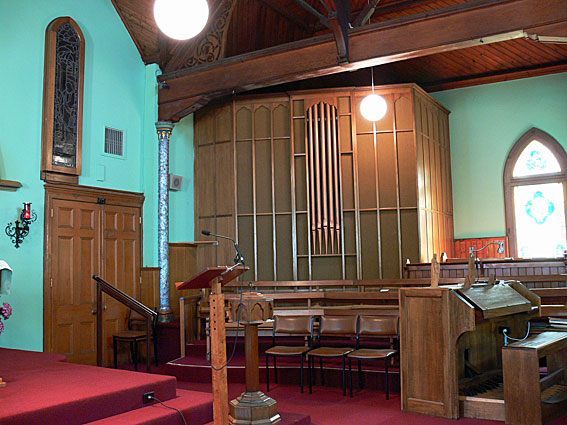
St Christopher’s Church, Camberwell – exterior from east
(photograph by John Maidment [8 November 2020])

St Christopher’s Church, Camberwell – exterior from east
(photograph by John Maidment [8 November 2020])
Historical and Technical Documentation by John Maidment
© OHTA, 2020 (last updated November 2020)
St Christopher’s Church was built as the Congregational Church, Camberwell. The foundation stone was laid on 7 January 1888 by James Mirams MLA and the building opened on 29 April of the same year. The architects were Loweish, Moorhouse and Figgis. The church was constructed from dark brown Hawthorn bricks in the Gothic style and cost £1,150 to erect.1,2 Transepts and vestries were added in 1900. It seems that this building was initially intended to serve as a hall for a larger church to be erected along Riversdale Road.
The partnership of the three architects was formed on 1 July 1886 and it carried out work in Melbourne, Sydney and as far afield as Brisbane. The partners were Richard Loweish, Frederick Moorhouse RIBA and Charles Douglas Figgis MVIA. This is thought to be its only church design although Figgis designed a number of churches in the Ballarat area on his own account.
The Congregational, or Independent, Church was prominent in Victoria in the second half of the 19th century and first half of the 20th century and erected many fine buildings, such as St Michael’s Church (originally the Independent Church) in Collins Street, Augustine Congregational Church, Burwood Road, Hawthorn (now an architect’s office), the Congregational Church, Malvern Road, Prahran (now Chapel off Chapel), the Congregational Church, Malvern (demolished), and the Congregational Church, Howe Crescent, South Melbourne, now used for other purposes.
It continued as a Congregational Church until the formation of the Uniting Church in 1977. It was reopened as St Christopher’s German Catholic Church in July 1983. This congregation was founded many years earlier and had previously met in Richmond. Its services are conducted entirely in the German language.

St Christopher’s Church, Camberwell – interior
(photograph by John Maidment [25 September 2012])
The building has been very sensitively conserved and the interior attractively repainted. A wooden altar is now sited where the pulpit was originally located. The interior also includes Victorian-period stations of the cross. The turned wooden roof trusses are highly distinctive.
The stained glass windows include the original leadlighting in the nave, the work of Brooks Robinson (1964) and two others taken from the Congregational Church, South St Kilda after its closure in 1973.

St Christopher’s Church, Camberwell – organ in its original location and with original case
(photograph from A.S. Gunson church history)

St Christopher’s Church, Camberwell – organ after removal to right transept
(photograph from Mrs Phillips [c.1955])

St Christopher’s Church, Camberwell – organ after 1961 rebuilding
(photograph by John Maidment [25 September 2012])
The organ originally dated from the mid-19th century and was built by an unknown British organbuilder. It was imported secondhand from Britain by Melbourne organbuilder William Anderson and installed here in 1896, later moved to the right transept. It was the oldest pipe organ in the eastern suburbs of Melbourne. Very sadly, the rebuilding by Hill, Norman & Beard in 1961 saw the electrification of the action, installation of a detached stopkey console and particularly the removal of the delightful three-tower organ case, harkening back to 18th century models, all things that would not happen today. It is possible that script-engraved drawstops that came from the collection of Hill, Norman & Beard (now at Tanunda) came from this instrument.
| MANUAL Open Diapason Clarabella Dulciana Octave Flute Twelfth Fifteenth Cymbale 19.22 PEDAL Bourdon Flute Octave Flute Manual to Pedal |
8 8 8 4 4 2-2/3 2 II 16 8 4 |
grooved bass added 1961 A A A |
Compass: 61/30 (56 note windchest)
Electro-pneumatic action
Detached stopkey console
Cancel bars for Manual and Pedal stops3

St Christopher’s Church, Camberwell – 1961 detached console
(photograph by John Maidment [25 September 2012])

St Christopher’s Church, Camberwell – organ after 1961 rebuilding: interior
(photograph by John Maidment [25 September 2012])
1 The Argus, 9 January 1888, p.10
2 A.S. Gunson, A Short History of Camberwell Congregational Church 1888-1977
3 Specification noted 1966 John Maidment